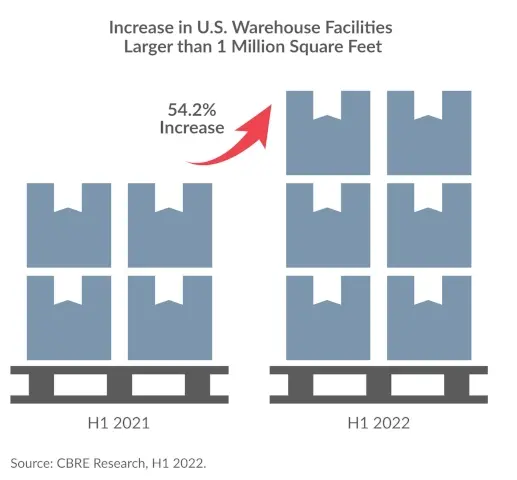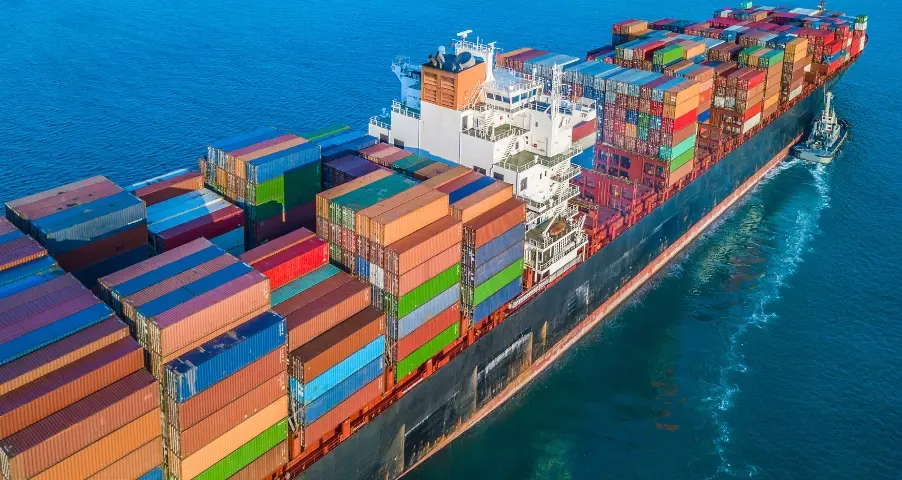MacroFab Blog
As traders and logistics firms strive to store goods to mitigate supply chain issues, they face a new challenge: there needs to be more space to store the goods in many locations in the United States. The COVID-19 pandemic has only amplified the trend, with a sudden surge in e-commerce demand leading to increased pressure on warehousing and logistics.
The warehousing crunch has put a strain on electronics companies that rely on quick delivery of electronic components or finished printed circuit boards, especially from overseas. With the shortage of warehouses and limited storage capacity, electronics producers face skyrocketing storage costs and delays in fulfilling orders.
Current Industrial Warehousing Space Shortage

According to a recent CBRE Group, Inc. report, the industrial warehousing market needs more space. In 2022, the U.S. hit a record-low vacancy rate and record-high rent growth. For example, leases for 700,000 sq. ft. or more increased by 24.6 percent. In addition, just 15 of the top 100 leases were renewals, indicating tenants are expanding their space.
Experts predict that the demand for industrial warehousing space will continue increasing in the coming years, driven by the growth of e-commerce. Additionally, As some news organizations have pointed out, in addition to stockpiling products for future sales, some companies reserve warehouse space when they can, regardless of whether they immediately need the space.
The Challenges of Manufacturing Overseas
Checkpoint
Keeping some on-hand inventory available at all times is the best way to offset unpredictable delivery schedules, but this requires warehouse space.

The warehousing shortage has become a growing concern in the industry, and the utilization of overseas manufacturing can exacerbate the situation. Supply chain disruptions, such as those caused by the COVID-19 pandemic, have resulted in longer delivery times for over 75 percent of companies, according to a survey by the National Retail Federation. This puts businesses at the mercy of overseas vendors who may experience unexpected disruptions, leading to inconsistent delivery times and difficulties in meeting product demand.
Keeping some on-hand inventory available at all times is the best way to offset such unpredictable delivery schedules, but this requires warehouse space.
Moreover, it’s not just the risks associated with a once-in-a-century pandemic that businesses need to consider. A study by McKinsey has revealed that supply chain disruptions of a month or longer can be anticipated every 3.7 years on average, with the most severe events having a substantial financial impact.

In the electronics industry, these disruptions can result in losses equal to approximately 42 percent of yearly profits over a decade. The study also highlighted that companies with more resilient supply chains suffered 60 percent less financial losses compared to those with less resilient supply chains.
Furthermore, longer supply chains also increase the likelihood of product damage or loss during transit, leading to substantial financial losses for businesses. According to the World Bank, the average cost of product damage during transportation is estimated to be around one percent of the total value of goods traded globally, which equates to billions of dollars.
The lack of control over delivery also poses a challenge for companies to guarantee the proper handling of their products, thereby increasing the risk of damage or loss.
Practical Suggestions to Navigate Warehouse Scarcity
Fortunately, there are steps that electronics producers can take to mitigate the effects of this supply chain issue.
Identify vulnerabilities and take steps to address them. The need for warehousing is deeply connected to supply chain vulnerabilities. Stockpiling on-hand inventory can be avoided by understanding where your sourcing risks reside. This requires mapping your entire supply chain, which can be a costly endeavor. However, it can be less costly than a surprise disruption that shuts down your business.
Use North American manufacturers to shorten supply lines and delivery times. By sourcing products from regional manufacturers, businesses can reduce their dependence on overseas suppliers and minimize the impact of supply chain disruptions. This can result in shorter delivery times, increased reliability, and decreased costs while decreasing the need for warehouse space.

Implement warehouse optimization strategies. Businesses can implement strategies to make the most of their available warehousing space. This may include implementing more efficient storage systems, reducing unnecessary inventory, and exploring automation and technology to streamline operations.
Find alternative warehousing options. This may include using smaller, local warehouses or exploring shared warehousing spaces with the help of digital technologies. MacroFab, for example, uses digital technologies to manage and streamline logistics. With the ability to manage production and delivery processes online, businesses can minimize their need for physical storage space and reduce the risk of supply chain disruptions.
How MacroFab’s Digital Technology can Help

One example of digital technology that can help navigate the warehousing crunch is MacroFab’s platform, which provides fulfillment capabilities for companies. MacroFab’s digital tools enable companies to efficiently order, store, and ship products to customers through a streamlined online process. MacroFab’s one-stop shop optimizes the product development process and helps companies get their product designs completed faster.
Digital technologies offer a powerful solution to the warehousing crunch. By leveraging these technologies, companies can minimize their dependence on traditional warehousing solutions, lower the risk of supply chain disruptions, and remain competitive in an increasingly challenging marketplace.
By using North American contract manufacturers, finding alternative warehousing options, and implementing warehouse optimization strategies with the help of digital tools, businesses can minimize the impact of the warehousing crunch and ensure that they are well-equipped to meet the growing demand for electronics products.
Related Topics
Preparing for Potential Supply Chain Disruptions During Lunar New Year
This blog discusses on how to prepare for unexpected events for global supply chains such as the dockworker strike in preparation for Lunar New Year.
Mapping Out a PCBA Supply Chain Strategy in Five Moves
Companies should create unique vendor relationships with numerous international suppliers due to the necessity of having to source components globally.
MacroFab’s Modern Approach to Strategic Sourcing
Many Contract Manufacturers (CMs) and Original Equipment Manufacturers (OEMs) have some sort of procurement team. So what makes MacroFab so different?
Let MacroFab help you with inventory and warehousing.
Strategic Electronics SourcingAbout MacroFab
MacroFab offers comprehensive manufacturing solutions, from your smallest prototyping orders to your largest production needs. Our factory network locations are strategically located across North America, ensuring that we have the flexibility to provide capacity when and where you need it most.
Experience the future of EMS manufacturing with our state-of-the-art technology platform and cutting-edge digital supply chain solutions. At MacroFab, we ensure that your electronics are produced faster, more efficiently, and with fewer logistic problems than ever before.
Take advantage of AI-enabled sourcing opportunities and employ expert teams who are connected through a user-friendly technology platform. Discover how streamlined electronics manufacturing can benefit your business by contacting us today.